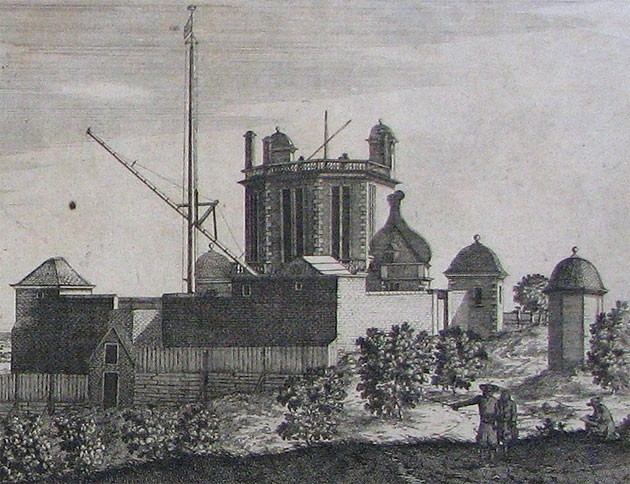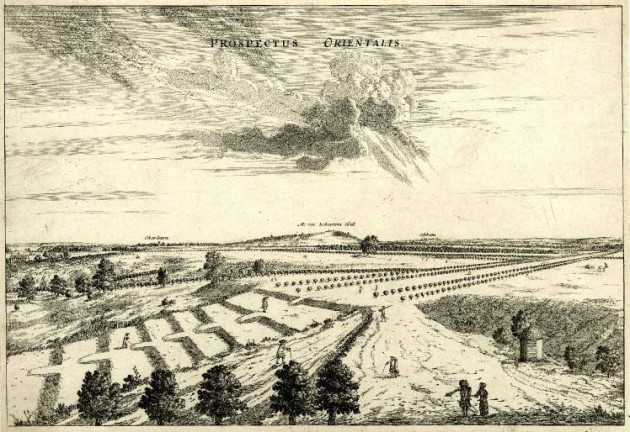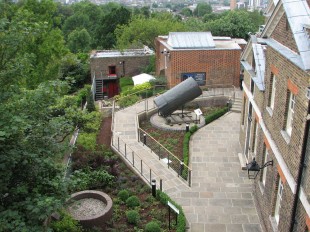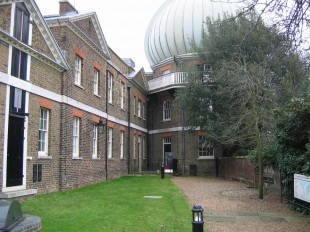…where east meets west
- Home
- Brief History
- The Greenwich Meridian
- Greenwich
(1675–1958) - Herstmonceux
(1948–1990) - Cambridge
(1990–1998) - Outstations (1822–1971)…
- – Chingford (1822–1924)
- – Deal
(1864–1927) - – Abinger
(1923–1957) - – Bristol & Bradford on Avon
(1939–1948) - – Bath
(1939–1949) - – Hartland
(1955–1967) - – Cape of Good Hope
(1959–1971)
- Administration…
- – Funding
- – Governance
- – Inventories
- – Pay
- – Regulations
- – Royal Warrants
- Contemporary Accounts
- People
- Publications
- Science
- Technology
- Telescopes
- Chronometers
- Clocks & Time
- Board of Longitude
- Libraries & Archives
- Visit
- Search
Telescope: Flamsteed’s Well Telescope (1676)

Flamsteed's Well Telescope. From Webster's Greenwich Park its History and Associations (London, 1902)
Background to parallax measurements with zenith telescopes
A zenith telescope consists of a vertically mounted telescope in which the position of a star can be measured with respect to the zenith (the point vertically overhead). The world’s first zenith telescope was made by Robert Hooke and used by him in 1669 in an attempt to provide observational evidence of the Copernican theory that the Earth was orbiting the Sun. Later telescopes were used in an attempt to measure the distances to the stars. By observing at the zenith the observations did not need to be corrected for atmospheric refraction, thereby removing a significant source of error.
Hooke’s telescope was mounted in his lodgings at Gresham College. To accommodate its length of 36 feet, holes had to be cut though the structure of the building. It passed from the though various floors and out through the roof. Hooke observed the brightest star to pass though the field of view – γ Draconis. What he had hoped to detect was an annual periodic shift in a north/south direction in the position of γ Draconis relative to the zenith as the Earth’s position in space changed during its orbit around the Sun. A commonly quoted analogy is the shifting in position against the background that occurs when an outstretched finger is observed first though one eye and then the other – the view of the finger from each eye being likened to the view of γ Draconis from the Earth when on opposite sides of its orbit. Hooke’s telescope was fraught with difficulties leading him to write:
‘With all these difficulties I was forced to adjust the instrument every observation I made, both before and after it was made, which hath often made me wish that I were near some great solid Tower, or some Rock or deep well, that so I might fix all thins at once, and not be troubled continually thus to adjust the parts of the said instruments,’.
Hooke made just four observations before managing to accidently break the object glass bringing his investigation to a premature end. It was possibly Hook’s suggestion of using a well that lead to the construction of Flamsteed’s Well telescope at Greenwich
The telescopes constuction and use
An extremely rare etching by Francis Place after Robert Thacker c.1677, of which a late Victorian copy (of regrettably poor quality) is reproduced to the right, shows a lined shaft, cutting through about 75 feet of upper strata before continuing unlined 25 feet into the chalk below where its diameter widens. A spiral staircase of what appear to be wooden steps leads down to where Flamsteed is shown lying on his back looking into the eyepiece. The shaft is topped by a hexagonal cupola. The telescope itself consisted of an object glass (OG) which was slotted into one of several recesses in the wall. A plumb-line extended from the lens down to the base of the shaft. This defined the zenith. The engraving shows it to be encased (or partially encased in a wooden tube) which can be seen running down the right-hand side of the shaft. Details of the eyepiece are obscure. Maunder interpreted the Place etching in 1903 as showing the eyepieces forming the plumb-bob . Howse (1975) supposes it to have been a lens of 8-inch focus that Flamsteed used to measure the focal length of the OG before mounting it. The telescope appears to have failed to work, as only two observations are recorded. They were made in 1679. There seem to have been several contributory factors to the telescope’s abandonment. One was the poor quality of the OG (see below). Another may have been the difficulty of getting the plumb-line to come to rest. James Hodgson (Flamsteed’s later Assistant) attributed it to ‘the damp of the place’. Laurie (1956) and Howse (1975) both carried out in depth investigations of Flamsteed’s correspondence and writings, and should be consulted for further details of the telescopes use and construction (links and references below).
Origin, location and depth of the well – the archaelogical and other evidence
The date of the well’s creation is unknown. It lay outside the domain of the original Observatory, roughly 25 metres to the east of where Flamsteed was to subsequently mount his Mural Arc. No evidence has ever been unearthed that it was dug for Flamsteed, leading to the supposition that it was either a remnant from Greenwich Castle or, rather less likely, a denehole comparable to others in the Blackheath vicinity. The underlying geology is a mix of sand and pebbles overlying chalk. The shaft was probably filled in during Flamsteed’s time and the brick/stone cupola demolished, its location becoming rapidly forgotten.
As well as the engraving mentioned above, Francis Place produced eleven others related to the Observatory and its instruments. The cupola is visible in two of these (one is a view looking towards the Observatory with London in the distance, the other, a view looking eastwards from the Octagon Room). The position of the well is shown on an engraved plan titled Ichnographia that was produced as part of the series. On the engraving reproduced at the top of the page, it is stated that the well is 100 feet deep. On the plan it is stated as 120 feet. Measurements made with a barometer on 20 February 1679 lead Laurie (1956) to infer a depth of 130 feet. As well as the uncertainty over the well’s depth, there was also historic uncertainty about the well’s location. Place’s Ichnographia showed it in a different place to a hand drawn plan by Flamsteed that is preserved in the Observatory archives at Cambridge (click here to read more about the plans). Flamsteed’s manuscript observations and correspondence were removed from the Observatory following his death in 1719. By the time they were eventually reacquired in 1771, all traces of the well had been obliterated.

The cupola of the Well Telescope (right) with Flamsteed House to the left. Detail from the etching Prospectus Versus Londinium by Francis Place after Robert Thacker c.1676. Reproduced by permission of the Greenwich Heritage Centre (see below)

The cupola of the Well Telescope (bottom right) as seen from the Octagon Room in Flamsteed's time. Etching by Francis Place after Robert Thacker c.1676. © Trustees of the British Museum (see below)
A subsidence that occurred in the vicinity of the wall in 1881, further convinced Airy that Flamsteed’s manuscript plan showed the well’s correct location.
During preparatory work for opening the Meridian Building as part of the National Maritime Museum in the 1960s, a concerted effort was made to locate the well’s position. Evidence of a shaft was found in the location indicated on Flamsteed’s manuscript plan at the junction of the former south and east boundary walls (the second of which was scheduled for demolition).
Excavated to a depth of about 12 feet by Messrs Carmichael (who are presumed to have been the Ministry of Works contactors), Lewisham Natural History Society were then called in to excavate it further. Their excavations ceased at a depth of 24 feet on grounds of safety. No real evidence of a brick lining had been found, and further shuttering would have been required to go deeper.
The evidence unearthed showed a shaft of diameter about seven feet six inches whose centre was located immediately to the north-west of the junction of the old south and east boundary walls. The shaft extended under both walls and slightly beyond. There was also evidence of a hexagonal building having stood on the ground above it (in keeping with Place’s etchings). The material recovered suggested that the shaft had been used as a dumping ground. Material recovered included pottery sherds, clay tobacco pipes, building material, animal bones, oyster shells, nails, glass, etc. Most of the pottery was dated to about 1700. The finds were deposited with the National Maritime Museum.
In the summer of 1967, with the Meridian Building about to be finally opened to the public, the spoil heap was removed and the shaft boarded over, with a view to possibly continuing the excavations at a later date. A large square wooden planter was placed on top and a sign put up stating ‘Site of Flamsteed’s Well Telescope 1676’. There is anecdotal evidence of subsidence having occurred adjacent to the well in 1984, at the spot where the day before Prince Philip had sat down for lunch during a tree planning ceremony.
When the Observatory was refurbished in the early 1990s, it was decided to remove the planter and mark the well’s ‘position’ with a circle of bricks on the ground. Somewhat misleadingly, its centre was located around half a metre to the north-west of the shaft’s centre. There was also no indication that it extended beneath the old south wall; the accompanying sign merely stating: ‘Site of Flamsteed’s Well Telescope 1676.’ This was later replaced with one containing additional text and a copy of Place’s etching. It has not yet been possible to establish if the shaft was filled in or capped off prior to the circle of bricks being laid. When the area was hard landscaped during 2008 and 2009, (still current in 2014), the circle of bricks was raised up by about seven courses giving it the appearance of a traditional well. The upper part of the south boundary wall was rebuilt at the same time. A new sign was created which rather more accurately included the words ‘This reconstructed circle of bricks indicates the approximate site of the well telescope’.

The site of Flamsteed's Well Telescope (bottom) in June 2009 following a major re-landscaping of the Meridian Garden
The object glass (OG)
Thought to have been made by Pierre Borel of Paris, the OG was inherited by Flamsteed’s Assistant, James Hodgson, who had married Flamsteed’s niece. He donated it to the Royal Society in 1737, where it was inscribed with its provenance. The lens was loaned to the Science Museum in 1932. In 1955, it was loaned briefly to the Royal Observatory so that tests could be carried out to ascertain its optical qualities. These were performed by Alan Hunter (then a Principal Scientific Officer, but later the Director of the Observatory) and EG Martin, who reported their findings in the journal The Observatory (see below), the OG from the Melbourne Reversible Transit Circle being used as part of the testing process. The lens was reported as being 9.75 inches in diameter, 0.36 inches thick and weighing 39.5 ounces with one surface nearly plane. The edge of the lens was reported as being chipped. The tests found that the lens was of ‘very poor quality, the resulting image consisting of a general blur with bright points superimposed’. It was found to have a refractive index in sodium light of 1.5204±0.0040, suggesting it was made of hard crown glass. The measured focal length was about 87 feet. (87 feet 5 inches ±0.7 inches in sodium light, 86 feet 11.2 inches at λ5270 and 87 feet 7.7 inches at λ6220)
Further reading
More recent articles in books and journals:
Flamsteed’s Well Telescope, Howse, Derek. Greenwich Observatory, Vol. 3, pp.58–60 & figs 52, 53 & 5 (London, 1975)
Flamsteed's well, Laurie, P. S. The Observatory, Vol. 76, pp. 24–25 (1956)
The Flamsteed 90-foot lens, Hunter, A. & Martin, E. G. The Observatory, Vol. 76, pp. 25–26 (1956)
Information regarding excavations:
Details of Excavations carried out on the Greenwich Site since 1965
Flamsteed's Well Greenwich, Willmot, F. Lewisham Natural History Society The Kent Archaeological Review (1969)
Full archaelological report, Lewisham Natural History Society, Darenthis, IV (1966), pp.7–17
British Geological Survey borehole records (7 pages drawn from historical sources)
Early twentieth century accounts (which should be read together):
Flamsteed's well, Lynn, W. T. The Observatory, Vol. 26, pp.102–103 (1903)
Flamsteed's well, Maunder, E. W. The Observatory, Vol. 26, pp.138–140 (1903)
Flamsteed's well, Lynn, W. T. The Observatory, Vol. 26, p.179 (1903)
Histories of parallax measurements:
The distances to the stars, Murray, C. A. The Observatory, vol. 108, pp. 199–217 (1988)
The Historical Search for Stellar Parallax, Fernie, J. D. Journal of the Royal Astronomical Society of Canada,
Vol. 69, pp.153–161
Vol. 69, pp.222–238
Vol. 70, p.40
Measurements of the Distances of the Stars, Dyson, F. W. Journal of the Royal Astronomical Society of Canada, Vol. 9, pp.407–422
Acknowledgements
Special thanks are due to the Greenwich Heritage Centre for permission to reproduce the engraving Prospectus Versus Londinium by Francis Place.
The engraving Prospectus Orientalis by Francis Place is reproduced by permission of the Trustees of the British Museum (Museum Number. 1865,0610.950).
© 2014 – 2025 Graham Dolan
Except where indicated, all text and images are the copyright of Graham Dolan
